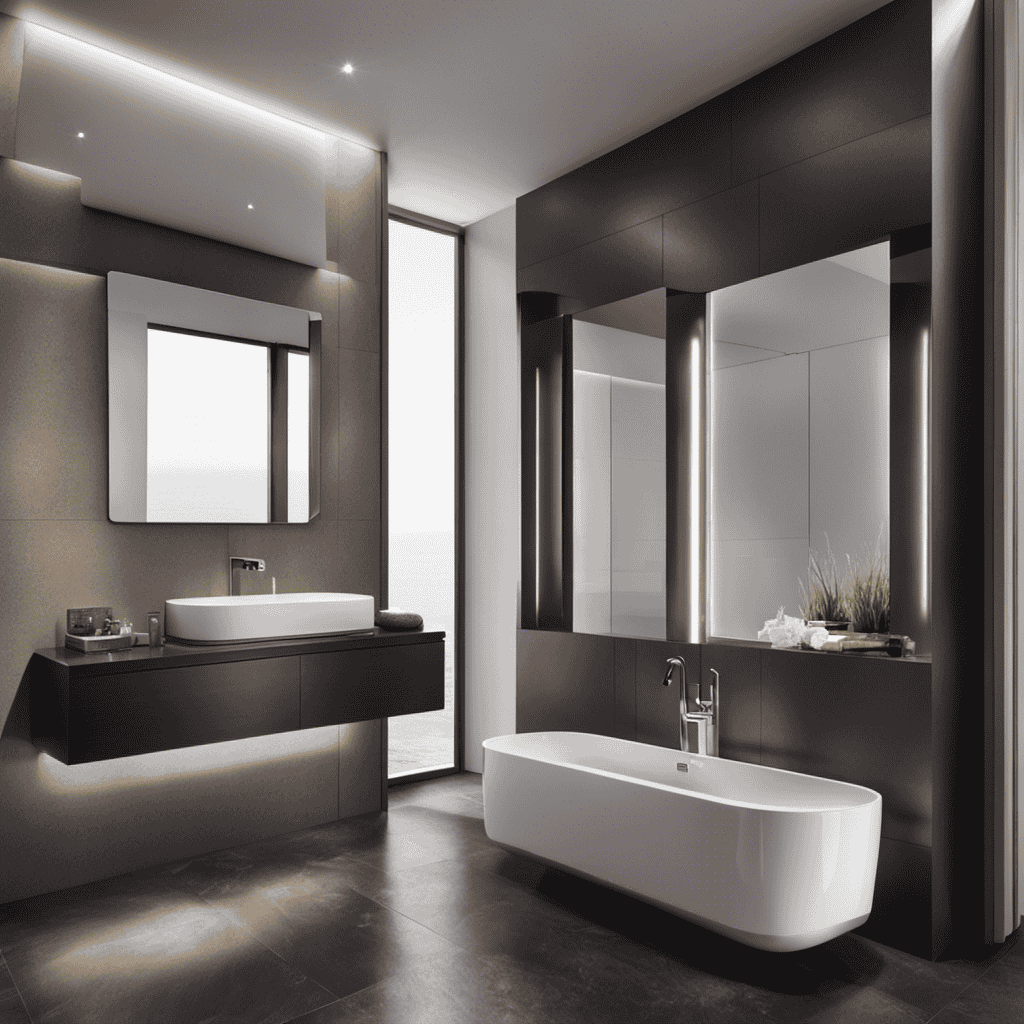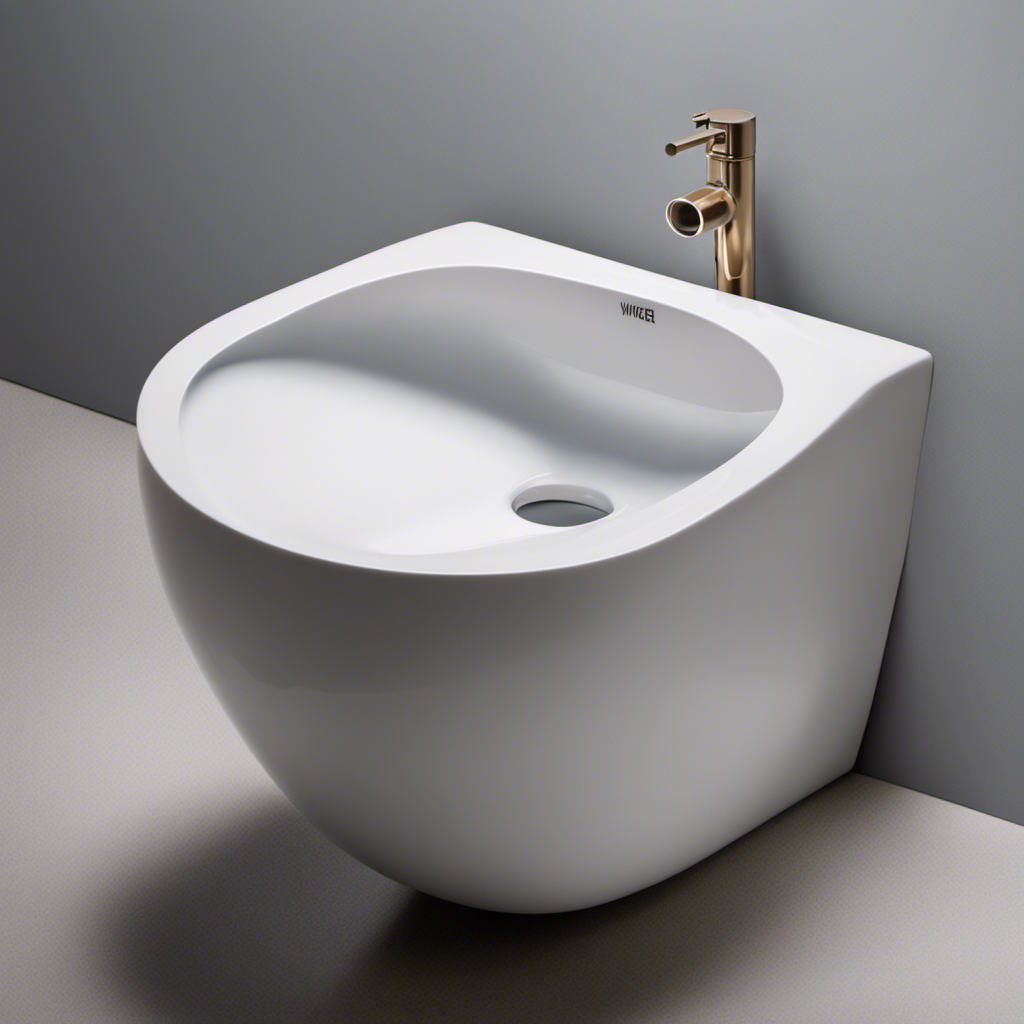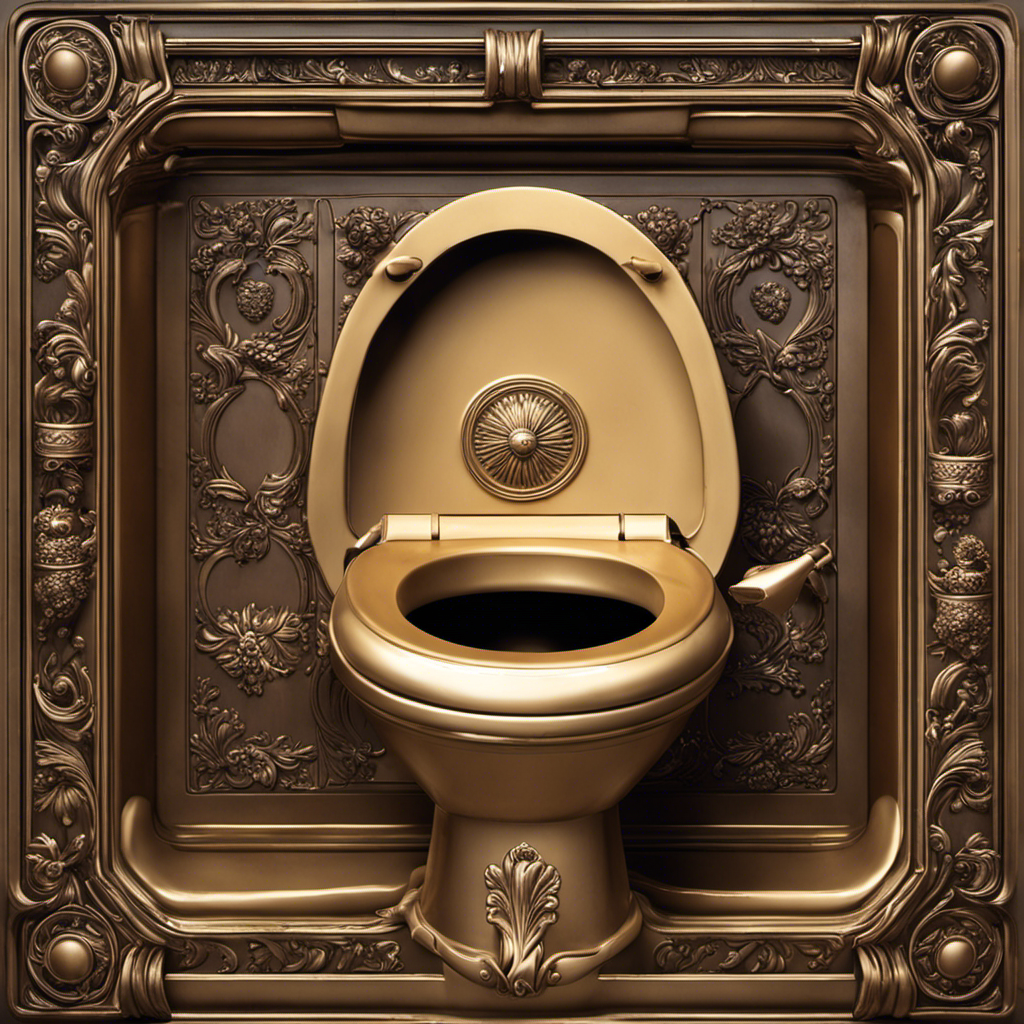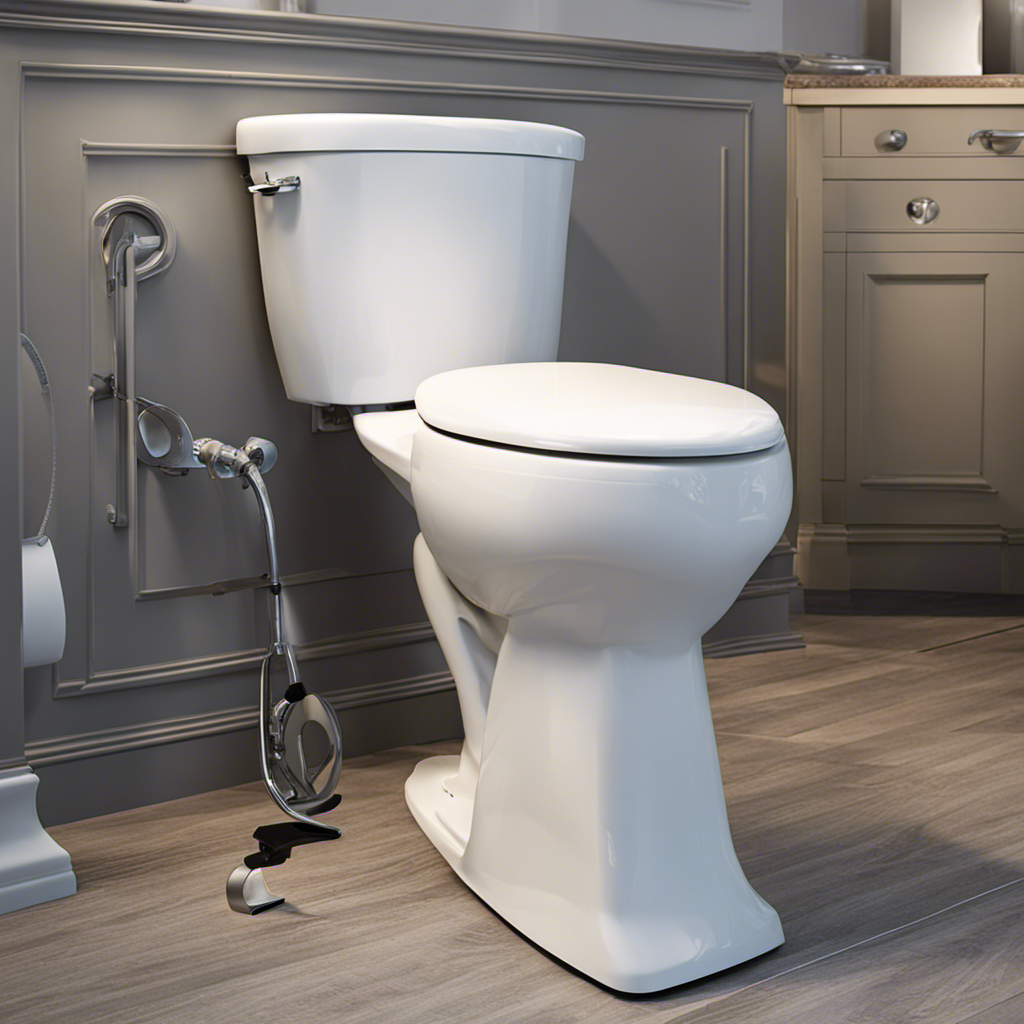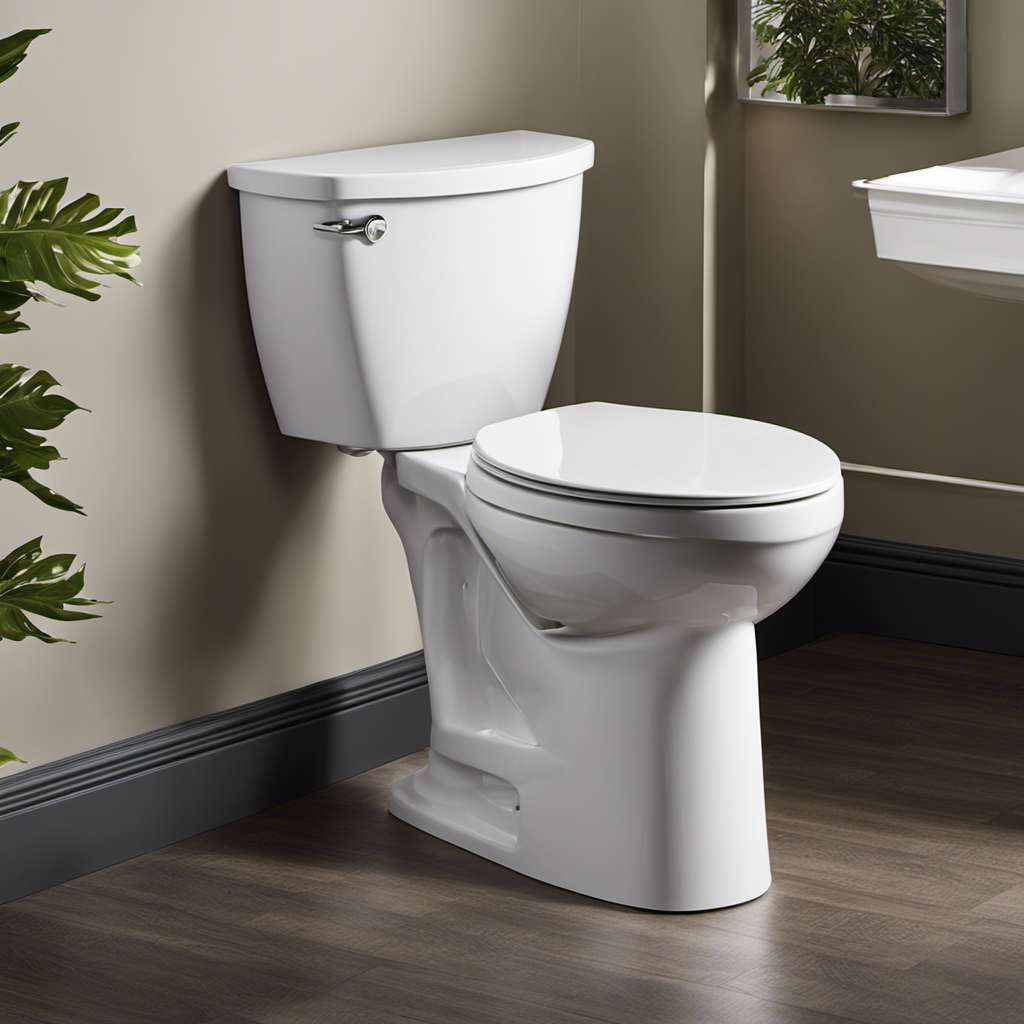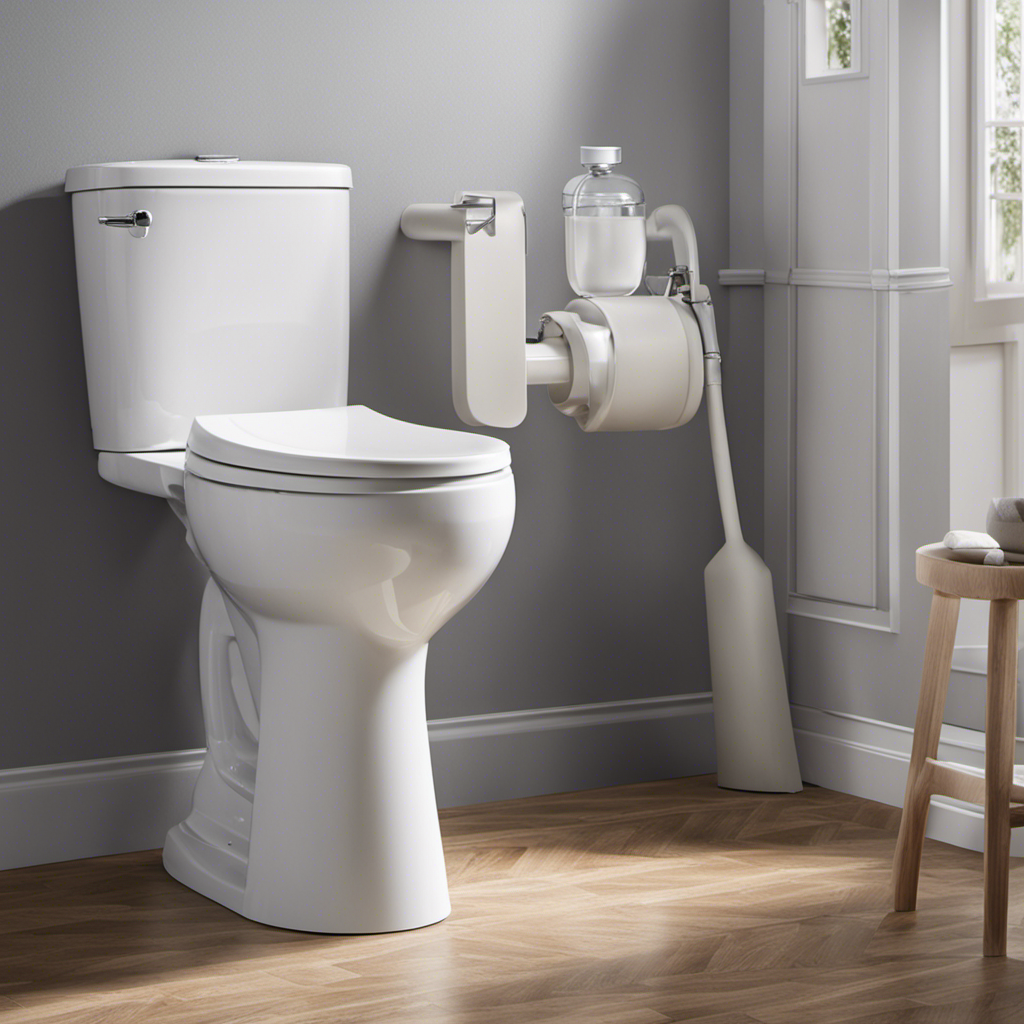As a plumbing professional, I have uncovered the secrets to maintaining water-efficient toilets.
From routine cleaning and inspections to replacing parts and seeking professional help when needed, there are numerous best practices to ensure your toilets conserve water.
In this article, I will share my expertise on these practices, answer common questions, provide tips for conserving water in the bathroom, and discuss the latest innovations in water-efficient toilets.
Join me as we explore the world of water efficiency and how to serve others through sustainable practices.
Key Takeaways
- Regularly inspect and maintain your toilets to check for leaks and promptly replace any worn-out or malfunctioning components.
- Consider installing water-efficient toilets like dual-flush or low-flow models that use less water per flush without compromising performance.
- Adjust the water level in the tank and install a toilet tank bank to optimize efficiency and reduce the amount of water used per flush.
- Cleaning the bowl, tank, and exterior surfaces regularly using non-abrasive cleaners will help maintain water efficiency and prevent potential issues.
Regular Cleaning for Water Efficiency
I make sure to regularly clean my toilet to maintain water efficiency. Regular maintenance is crucial for ensuring that your toilet continues to function optimally and uses water efficiently. There are several cleaning techniques that can help achieve this.
Firstly, use a toilet brush and a mild cleaner to scrub the bowl and remove any mineral deposits or buildup. Pay special attention to the rim and the siphon jets to ensure proper flushing.
Additionally, clean the tank and the flapper valve to prevent any leaks or water wastage. By regularly cleaning your toilet, you can prevent clogs, maintain water flow, and ensure that it operates efficiently.
However, cleaning alone isn’t enough; routine inspection is also important to identify any potential issues and address them promptly.
Importance of Routine Inspection
During routine inspections, it’s important to thoroughly check all components of the toilet for any signs of damage or malfunction. This ensures that the toilet is in proper working condition and can help prevent any potential issues from escalating.
Here are some key points to consider during routine maintenance:
-
Check for leaks: Inspect the toilet tank and bowl for any signs of leakage. This can be done by adding a few drops of food coloring into the tank and checking if it appears in the bowl without flushing.
-
Test the flush mechanism: Ensure that the flush handle is working properly and that the toilet flushes with sufficient force.
-
Examine the fill valve: Check if the fill valve is functioning correctly and if the water level in the tank is at the recommended level.
Replacement Parts for Water-Efficient Toilets
Although it can be challenging to find replacement parts for water-efficient toilets, it’s essential to ensure their proper functioning and efficiency.
One common replacement part that may need to be replaced is the toilet flapper. The flapper is responsible for sealing the flush valve and preventing water from continuously flowing into the toilet bowl. Over time, the flapper can deteriorate or become misaligned, causing leaks and wasting water. To replace the flapper, turn off the water supply to the toilet, remove the old flapper, and install the new one according to the manufacturer’s instructions.
Another crucial replacement part is the fill valve. The fill valve controls the water level in the toilet tank and is essential for proper flushing. If the fill valve is malfunctioning or leaking, it can lead to water waste. To replace the fill valve, turn off the water supply, drain the tank, disconnect the old fill valve, and install the new one following the manufacturer’s guidelines.
Regularly inspecting and replacing these parts will ensure the water efficiency of your toilet and help conserve water.
When to Consider Professional Plumbing Services
One important consideration is to call professional plumbing services if you encounter multiple instances of toilet leaks in a short period of time. As a homeowner, it’s tempting to try to fix plumbing issues yourself, but there are certain signs of plumbing problems that shouldn’t be ignored.
Here are some key indicators that it’s time to leave the DIY approach behind and seek professional help:
- Persistent leaks that keep occurring despite your attempts to fix them.
- Low water pressure throughout your home, indicating a potential blockage in the pipes.
When faced with these signs, it’s crucial to involve professional plumbing services. They have the expertise and specialized tools to accurately diagnose and repair complex plumbing issues. Plus, they can provide valuable advice on how to prevent future problems, saving you time and money in the long run.
Why Professional Plumbing Services Are Necessary
Professional plumbing services are necessary because they provide the expertise required to handle complex plumbing issues.
From installing new fixtures to repairing leaks, professional plumbers have the knowledge and experience to ensure the job is done correctly and efficiently.
Attempting to tackle plumbing problems without professional help can lead to costly mistakes and further damage to the plumbing system.
Importance of Expertise
I believe that expertise plays a crucial role in ensuring the effectiveness of plumbing services. When it comes to plumbing, having the necessary skills and knowledge can provide several advantages.
Advantages of Expertise:
- Efficient Problem Diagnosis: A skilled plumber can quickly identify the root cause of plumbing issues, saving time and money.
- Quality Workmanship: Expertise ensures that plumbing services are performed accurately and up to industry standards, minimizing the risk of future problems.
Importance of Skill:
- Safety: Plumbing systems can be complex and potentially dangerous if mishandled. Expertise ensures that work is done safely and reduces the risk of accidents.
- Longevity: Skilled plumbers can provide lasting solutions that prevent recurring problems, saving homeowners from the inconvenience and expense of frequent repairs.
Avoiding Costly Mistakes
By understanding the importance of avoiding costly mistakes in plumbing, it enables me to provide efficient and reliable services to my customers. When it comes to preventing water waste in toilets, there are several tips that can help homeowners save both water and money. One of the most common mistakes to avoid is a leaky toilet. A leaking toilet can waste hundreds of gallons of water each day, leading to high water bills. Regularly checking for leaks and repairing them promptly is essential. Additionally, using water-efficient toilets can greatly reduce water consumption. Installing dual-flush toilets or low-flow toilets can significantly decrease the amount of water used per flush. Finally, educating homeowners about proper toilet usage, such as avoiding flushing non-flushable items, can prevent clogs and costly repairs.
| Costly Mistakes to Avoid | Tips for Preventing Water Waste |
|---|---|
| Leaky toilets | Regularly check for leaks and repair promptly |
| Inefficient toilets | Install water-efficient toilets (dual-flush or low-flow) |
| Flushing non-flushable items | Educate homeowners about proper toilet usage |
Long-Form Answer on Maintaining Water Efficiency
My toilet’s water efficiency can be maintained by following these long-form guidelines:
Regular maintenance:
- Check for leaks: Conduct regular inspections to ensure there are no leaks in the toilet tank or plumbing.
- Replace faulty parts: If any components, like flappers or fill valves, are worn out or malfunctioning, replace them promptly.
Water-saving modifications:
- Install a dual-flush system: This allows you to choose between a full flush or a reduced flush, conserving water for liquid waste.
- Adjust the fill valve: Ensure the water level is set correctly, neither too high nor too low, to optimize efficiency.
Maintaining water efficiency in toilets offers several benefits:
- Reduced water consumption: By using less water for each flush, you contribute to conservation efforts and reduce your water bill.
- Environmental impact: Conserving water helps preserve this precious resource and minimizes the strain on local ecosystems.
- Sustainability: By adopting water-efficient practices, you contribute to a more sustainable future for generations to come.
Other Ways to Maintain Water Efficiency in Toilets
Installing a low-flow toilet is another effective way to maintain water efficiency in toilets. These toilets are designed to use less water per flush, helping to conserve water and reduce water bills. The key to their efficiency lies in the toilet tank and flush mechanism.
Low-flow toilets have a smaller tank capacity, typically around 1.6 gallons or less, compared to traditional toilets that use around 3 to 5 gallons per flush. Additionally, they feature innovative flush mechanisms that optimize water usage. Some models use pressure-assisted technology to create a powerful flush with less water, while others utilize dual-flush systems that allow users to choose between a partial flush for liquid waste and a full flush for solid waste.
Common Questions About Water-Efficient Toilets
When it comes to water-efficient toilets, there are often common questions that arise. People may wonder about the benefits of water-efficiency, how to properly install and maintain these toilets, and the cost-saving advantages they provide.
In this discussion, we’ll explore these points in detail to provide you with the necessary information for keeping your toilets water-efficient.
Benefits of Water-Efficiency
Water-efficiency is undeniably important for both the environment and my wallet. When it comes to saving water, there are several best practices to keep in mind:
-
Invest in a dual-flush toilet: These toilets have two buttons, allowing you to choose a smaller flush for liquid waste and a larger flush for solid waste. This can significantly reduce water usage.
-
Install a toilet tank bank: This simple device displaces water in the toilet tank, reducing the amount used per flush.
-
Consider a low-flow toilet: These toilets are designed to use less water per flush without compromising performance.
Implementing these best practices not only leads to long term savings on water bills, but also has a positive environmental impact. Conserving water helps to reduce strain on local water supplies and protects ecosystems that rely on them. By making these changes, we can serve not only ourselves but also future generations by preserving this vital resource.
Installation and Maintenance Tips
I have recently learned some helpful installation and maintenance tips for water-efficient toilets, and I’d like to share them with you.
When it comes to toilet installation, it’s important to ensure a proper connection to the water supply. Start by shutting off the water and removing the old toilet. Inspect the flange and replace it if necessary. Use a wax ring or a flexible rubber gasket to create a watertight seal between the toilet and the flange.
When it comes to toilet maintenance, regular cleaning is essential. Use a non-abrasive cleaner and a soft brush to clean the bowl, tank, and exterior surfaces. Check for any leaks or running water and promptly repair any issues.
Lastly, consider installing a dual-flush mechanism or adjusting the water level to further reduce water consumption.
Cost-Saving Advantages
There are many cost-saving advantages to using water-efficient toilets, such as lower water bills and reduced water consumption. Here are a few key benefits to consider:
-
Financial savings:
-
Water-efficient toilets can significantly lower water bills, saving you money in the long run.
-
By reducing water consumption, you contribute to cost-saving strategies that benefit both your wallet and the environment.
-
Eco-friendly alternatives:
-
Water-efficient toilets help conserve water resources, promoting sustainability and environmental stewardship.
-
With their advanced flushing mechanisms, these toilets effectively remove waste while using less water, making them an eco-friendly choice.
Tips for Conserving Water in the Bathroom
I’ve found that simply turning off the faucet while brushing my teeth can make a significant difference in conserving water in the bathroom. But there are more ways we can reduce our water usage in this part of our homes.
Installing water-saving fixtures and using eco-friendly bathroom products are effective strategies to achieve a more sustainable bathroom. Water-saving fixtures such as low-flow showerheads and faucets can reduce water consumption by up to 50%. These fixtures restrict the flow of water without compromising performance, allowing us to still enjoy a satisfying shower or a refreshing hand wash.
Additionally, using eco-friendly bathroom products such as biodegradable soaps and shampoos eliminates harmful chemicals from entering our water systems. By adopting these practices, we can contribute to water conservation efforts and create a more sustainable future.
Now let’s explore some exciting innovations in water-efficient toilets.
Innovations in Water-Efficient Toilets
Water scarcity is a pressing issue in today’s world, and finding ways to conserve water is crucial. In recent years, there have been significant advancements in toilet design trends and technological advancements that contribute to water conservation.
Here are some of the latest innovations in water-efficient toilets:
-
Dual-flush toilets: These toilets offer two flushing options, typically a full flush and a half flush, allowing users to choose the appropriate water volume for each use.
-
Pressure-assisted toilets: These toilets use compressed air to enhance flushing power, reducing the amount of water needed for efficient flushing.
These advancements in toilet technology not only save water but also help homeowners and businesses lower their water bills while serving the greater cause of conserving our precious water resources.
Frequently Asked Questions
How Often Should I Clean My Water-Efficient Toilet?
I clean my water-efficient toilet every week to ensure it remains in optimal condition. Regular cleaning helps prevent any build-up of dirt or residue that can affect its efficiency.
Keeping a clean toilet not only ensures proper functionality but also has environmental benefits. Water-efficient toilets use less water per flush, reducing water consumption and lowering utility bills.
What Are Some Signs That Indicate My Water-Efficient Toilet May Need a Routine Inspection?
When it comes to water-efficient toilet maintenance, routine inspection signs are crucial. These signs indicate if your toilet needs attention. Look out for leaks, strange noises, or a decrease in flushing power.
Regularly inspecting your toilet ensures that it continues to operate efficiently and saves water. It’s important to stay proactive in maintaining your water-efficient toilet to avoid any potential issues in the long run.
Where Can I Purchase Replacement Parts for My Water-Efficient Toilet?
I recently had to find replacement parts for my water-efficient toilet and I found that the best place to look is online retailers. They’ve a wide range of toilet parts available, from flappers to fill valves, at affordable prices.
It’s important to choose the right parts for your specific toilet model to ensure proper functioning and water efficiency. Online retailers make it convenient to browse and compare options, so you can easily find the right parts for your water-efficient toilet.
Are There Any Specific Situations Where Professional Plumbing Services Should Be Considered for Water-Efficient Toilets?
In emergency situations where a toilet is malfunctioning or when new installations are being done, it’s advisable to consider professional plumbing services for water-efficient toilets.
One interesting statistic to note is that a leaky toilet can waste up to 200 gallons of water per day.
Hiring a professional plumber ensures that any issues with the toilet’s water-efficiency are properly addressed, saving both water and money in the long run.
Can You Provide Examples of Innovations in Water-Efficient Toilets That Are Currently Available in the Market?
Innovative designs and cutting-edge technology are revolutionizing water-efficient toilets. Manufacturers are constantly developing new features to reduce water consumption without compromising performance.
For example, some toilets now have dual flush options, allowing users to choose between a partial or full flush depending on their needs. Others use pressure-assisted systems that use air to propel water, resulting in a more efficient flush.
These advancements in water-efficient toilets are making a significant impact in conserving water resources.
Conclusion
In conclusion, adopting water-efficient practices for your toilets is crucial in conserving water and reducing utility bills.
Did you know that by simply replacing an old toilet with a water-efficient one, you can save up to 13,000 gallons of water per year? This statistic highlights the significant impact that small changes can make in promoting a more sustainable future.
So, by implementing the best practices mentioned in this article, you can contribute to water conservation efforts and minimize your environmental footprint.
